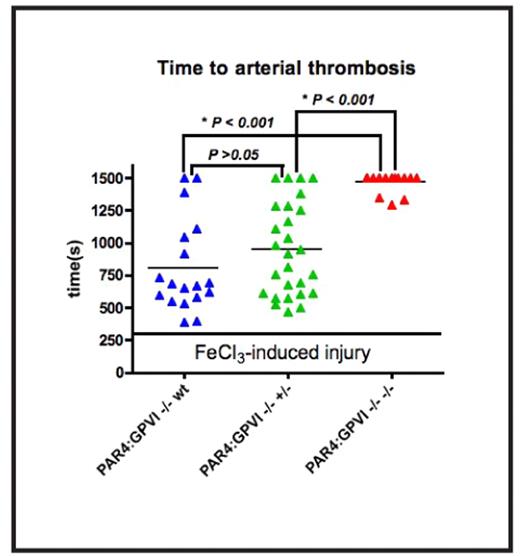Abstract
Following vascular injury, platelets are recruited and activated by adhesive proteins exposed on the subendothelium (including collagen), released agonists and locally generated thrombin. In mice, protease activated receptor 4 (PAR-4) mediates the platelet signaling response to thrombin. Previous studies showed that platelets from PAR-4 null mice do not respond to thrombin and while platelet thrombi do form at the site of injury in PAR-4 deficient animals, they do not propagate and extend into the lumen like thrombi in wild-type mice. The activation pathway responsible for this juxtamural platelet accumulation remains unknown. The collagen exposed on the subendothelium activates and recruites platelets at the site of injury by interacting with membrane glycoprotein (GP) VI. Therefore, the collagen-GP-VI pathway is a putative candidate for the platelet thrombus formation near the vessel wall. Using hirudin as a thrombin inhibitor in mice with disrupted GP-VI expression, it has been previously shown that GP-VI signaling and thrombin activation pathways may cooperate during thrombus growth. To more precisely evaluate the interplay between the thrombin/PAR-4 and collagen/GP-VI signaling pathways, we crossed mice lacking PAR-4 and GP-VI, and subsequently compared bleeding time and arterial thrombus formation in PAR-4:GP-VI double or single deficient animals. All genetic combinations were born at the expected mendelian distribution. Double deficient females carried offspring to term and no bleeding was observed during parturition. Pups lacking both receptors demonstrated transient perinatal abdominal bleeding which resolved rapidly. However, we observed prolonged tail bleeding times in double deficient animals compared to their single deficient littermates. Furthermore in a FeCl3-induced carotid thrombosis model, mice lacking both receptors were completely protected compared to their littermates. This study suggests that there is an interaction between the thrombin and collagen activating pathways in the setting of hemostasis and thrombosis.
Disclosures: No relevant conflicts of interest to declare.
Author notes
Corresponding author



This feature is available to Subscribers Only
Sign In or Create an Account Close Modal